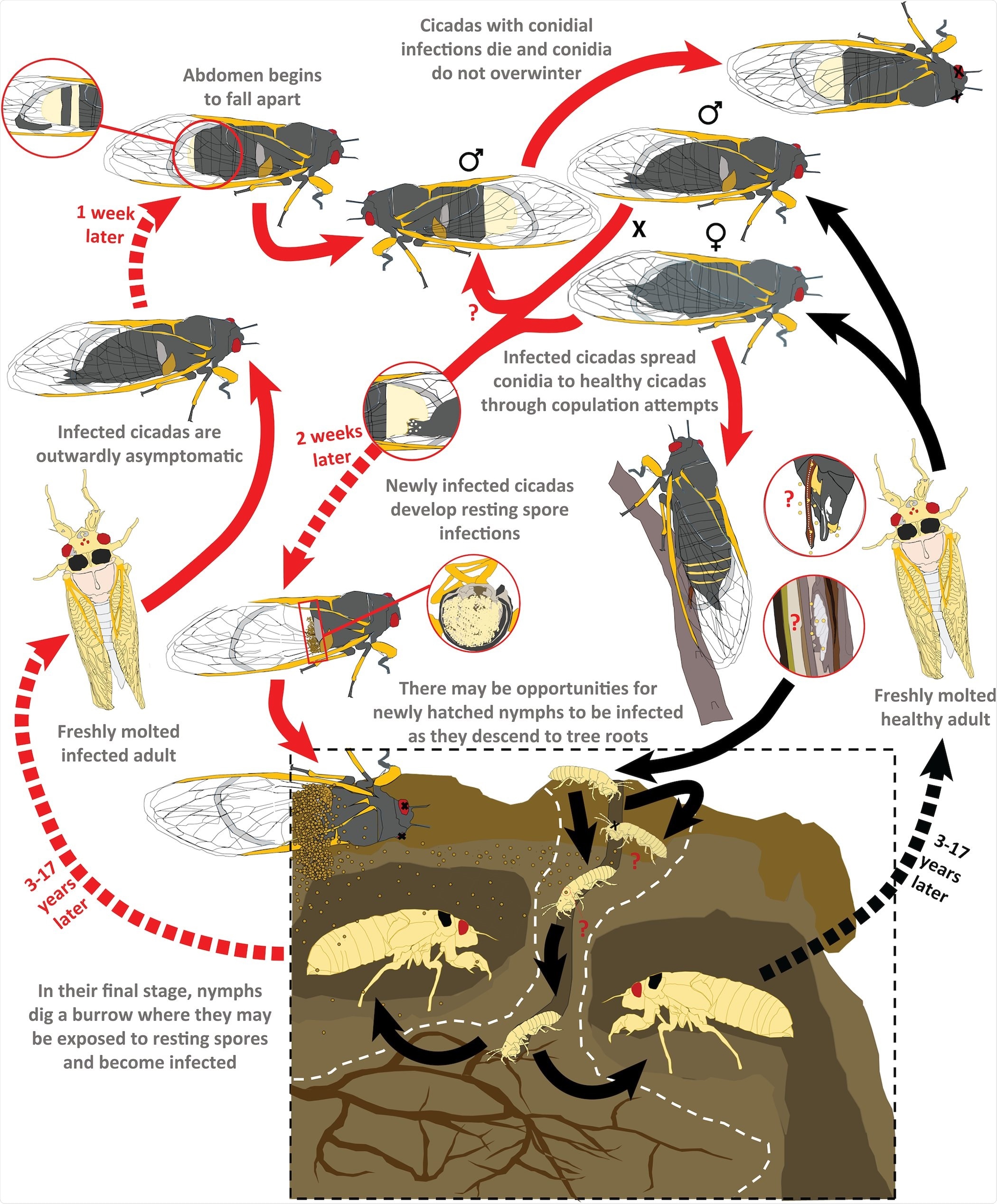Mind-controlling fungus that infects the brains of cicadas can make them kill each other. These mutant critters, dubbed as zombie cicadas, are forced to infect other insects.
A new study, published in the journal PLOS Pathogens, describes the insects that are infected with Massospora, a psychedelic fungus that contains chemicals such as those found in hallucinogenic mushrooms.

West Virginia University researchers were part of a team that discovered how Massospora, a parasitic fungus, manipulates male cicadas into flicking their wings like females – a mating invitation – which tempts unsuspecting male cicadas and infects them. (WVU Photo/Angie Macia
Transmission of Massospora
The researchers from the Division of Plant and Soil Sciences, West Virginia University, Morgantown, West Virginia, and Department of Microbiology and Plant Pathology and Institute for Integrative Genome Biology, University of California, compared the transmission of Massospora, known as active host transmission (AHT) to that of rabies.
An active host transmission is a form of biological puppetry wherein the pathogen controls the behavior of the host species. The team explains that when a male cicada becomes infected with the fungus, it will start copying the wing-flicking behavior that is usually exclusive to female cicadas. As a result, other male cicadas will be lured, thinking these are female cicadas wanting to mate.
"Essentially, the cicadas are luring others into becoming infected because their healthy counterparts are interested in mating. The bioactive compounds may manipulate the insect to stay awake and continue to transmit the pathogen for longer," Brian Lovett, study co-author and post-doctoral researcher with the Davis College of Agriculture, Natural Resources and Design, said.
How Massospora infect cicadas
Massospora start to eat away the cicada's genitals, abdomen, and butt, replacing them with fungal spores. From there, they cicadas wear away like an eraser on a pencil.
While more than a third of the insect's body is replaced with fungal tissue, infected cicadas continue to move around as if nothing happened. The fungus manipulates the behavior of the insect to keep the host alive, maximizing spore dispersal.
It is akin to a living dead, wherein the infected cicadas will continue to exist but in a mutated form, like a zombie. The spores that form in each of the cicada's abdomen can be dropped onto other cicadas to further spread the disease.
Massospora-infected cicadas contain psychoactive compounds, including cathinone and psilocybin. These chemicals alter the brain and behavior of the insects.

Comparing to rabies
Both rabies and entomopathogenic fungi, which are a parasite that destroys insects, perform active host transmission. This means that when infected, the behavior of the host changes.
For instance, people infected with rabies become aggressive, afraid of water, and do not want to swallow. Rabies can be transmitted through saliva, and when a person gets infected, the changes in behavior make them aggressive enough to bite other people, potentially transmitting the deadly virus to others.
The same is true with cicadas infected with Massospora. They experience a change in behavior, causing the insect to do things that are not in their free will, or that are unnatural for them.
Discovering infected cicadas
The infected cicadas, which were discovered in West Virginia by researchers, including Matthew Kasson, an associate professor of plant pathology and mycology, are a third cicada population found to have been infected by the mind-controlling fungus.
"Our previous literature always mentioned the strange behaviors associated with Massospora and some closely-allied fungi, but what was missing was a synthesis of all this new information that had come to light," Kasson explained.
"The most interesting finding is the things we still don't know. We realized that there were some possible scenarios for an infection that we had not considered before," he added.
Studying how Massosporaa infects cicadas can be hard since the insects have either a 13-year or a 17-year life cycle and live underground until they appear more than a decade later.
"The fungus could more or less lay in wait inside its host for the next 17 years until something awakens it, perhaps a hormone cue, where it possibly lays dormant and asymptomatic in its cicada host," Kasson added.
The team also explained why cicadas begin appearing again. Cicadas have different broods that emerge at different periods. Some cicadas appear every 13 years, and others come out every 17 years.
Though these infected creatures sound grotesque, they are generally safe to humans. The cicadas also reproduce at a rate that the fungi's extermination of hordes has only a small effect on their overall population.
Return of the zombie cicadas: WVU team unearths manipulative qualities of fungal-infected flyers
Source:
Journal reference:
- Lovett, B., Macias, A., Stajich, J., Colley, J., Eilenberg, J., Kasson, M., and Licht, H. (2020). Behavioral betrayal: How select fungal parasites enlist living insects to do their bidding. PLOS Pathogens. https://journals.plos.org/plospathogens/article?id=10.1371/journal.ppat.1008598